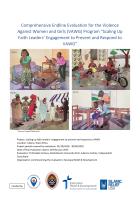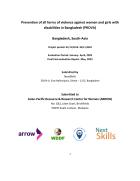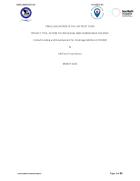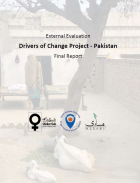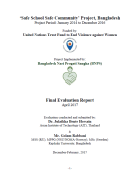1 - 8 of 8 Results
Date:
The Episcopal Relief & Development organization in Liberia implemented a three-year project entitled “Scaling Up Faith and Youth Leaders' Engagement to Prevent and Respond to Violence Against Women and Girls in Liberia” from 2018 to 2022 with the support of the UN Trust Fund. This second phase project aimed to reduce instances of intimate partner violence and non-partner sexual violence experienced by women and girls while enhancing their access to services. The final evaluation found that the project demonstrated the power of investing in faith leaders and youth in catalysing community change to prevent and respond to violence against women and girls.
Date:
The Asian-Pacific Resource and Research Center for Women (ARROW) implemented a three-year project, “Prevention of all forms of violence against women and girls with disabilities in Bangladesh (PROVA)”, with the support of the UN Trust Fund. The project aimed to ensure access to justice for women and girls living with disabilities who face violence, abuse, neglect, discrimination and exploitation. The final evaluation found that the project had enhanced awareness and knowledge of, and support for, disability rights, while effectively addressing abuse and improving the reproductive health of women and girls living with disabilities.
Date:
In Liberia, United Funding and Development for Underage Mothers (UFDUM) implemented the three-year project “Action to end sexual and gender-based violence” between 2020 and 2022 with the support of the UN Trust Fund. This project aimed to improve the well-being and quality of life of women and girls in Montserrado and Grand Cape Mount Counties, and their safety from sexual and gender-based violence. The final evaluation found that the project contributed to improved well-being and quality of life of women and girls.
Date:
The UN Trust Fund to End Violence against Women supported the three-year “Drivers of Change” project implemented by Shirkat Gah-Women's Resource Centre. The project aimed to shift attitudes at the community level and increase women’s economic empowerment. The final evaluation found that changes at the individual level, especially among women and girls, improved prevention of and response to violence against women and girls.
Date:
The project “Curb Early Child Marriage Through Human Rights Education and Advocacy in Sindh, Pakistan”, implemented by the Sindh Community Foundation, was funded from January 2016 to December 2017 by the UN Trust Fund to End Violence against Women. The final evaluation found that the project had increased knowledge and shifted attitudes about the protection of girls from early marriage as well as the legal consequences of the Sindh Child Marriages Restraint Act 2013.
Date:
The project “Engaging Faith-Based Organizations to Prevent Violence against Women & Girls and Increase Survivors’ Access to Services”, implemented by Episcopal Relief and Development, was funded from January 2015 to December 2017 by the UN Trust Fund to End Violence against Women. The final evaluation found that local participation in faith-based activities – where awareness was raised about gender-based violence and available support services – resulted in significantly less violence against women and girls.
Date:
Bangladesh Nari Progati Sangha implemented the project “Safe Schools Safe Communities” between January 2014 and December 2016 with grant support from the UN Trust Fund to End Violence against Women. The final evaluation found that the project succesfully addressed the specific needs of girls to allow them to be empowered and protected from gender-based violence in their schools and community.
Date:
The project Anti-Harassment Committee and Violence Prevention System in Export-Oriented Garment Factories was implemented in south India and Bangladesh by the Fair Wear Foundation from October 2011 to March 2015, with support from the UN Trust Fund to End Violence against Women. The final evaluation found the project was effective in responding to the needs of women and girls in the garment industry, and that some innovative ideas had been developed that could be useful in other sectors.
